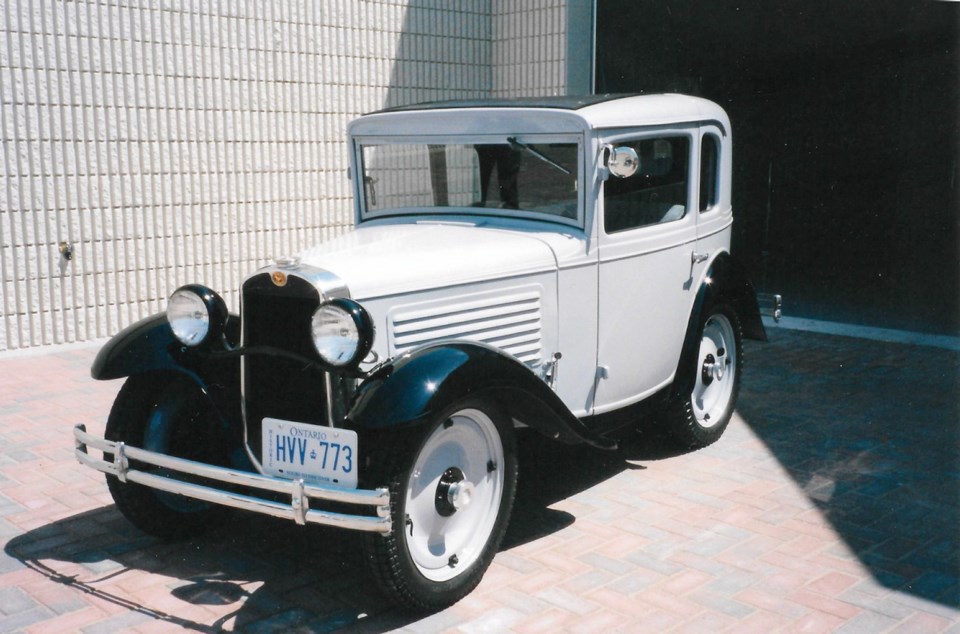When the tiny Austin Seven was introduced by Austin Motor Co. of Birmingham, England, in 1922, it proved so successful there would also be French, German and Japanese versions. It was decided that an Americanized model would likely appeal to North Americans, so the American Austin Co. was incorporated in Delaware and a plant established in Butler, Pennsylvania, in 1929.
The American Austin was introduced at a private trade showing in New York in January 1930. With the 1929 stock-market crash and the resulting Great Depression, it seemed like the ideal time to be launching a small, economical car. Sir Herbert Austin himself came over from England to launch it, and within a week, about 4,000 dealers had signed up.
The Austin was really small by American standards. With a 1,905-millimetre wheelbase, 1,016-mm track and length of only 2,667 mm, it resembled an oversized pram. Weight was a mere 513 kilograms.
To put this in some perspective, the 1930 American Model A Ford had a 2,629-mm wheelbase, was 3,937 mm long and weighed 1,077 kg.
The little inline side-valve four-cylinder engine displaced 747 cc (45.6 cu. in.) and developed 13 horsepower. American Austin claimed 40 miles per gallon and promoted it as a second car. It came as a coupe, followed by a two-passenger roadster and quarter-ton van.
Alas, in spite of the Depression, the American Austin fell far short of the expected 60,000 first-year sales. By the end of 1930, only 8,558 were built and the company lost about $1 million. Inventory was carried over into 1931 when production fell to only 1,279.
Sales improved in 1932 to 3,846 vehicles produced. This financed an upgrade in 1933 models with more stylish bodies and engine improvements that brought quieter operation, better performance and even higher fuel economy.
A new coupe model had two tiny child “seats” in the rear, and production reached 4,726 American Austins in 1933, but still lost money.
Entering 1934, failure loomed, and in June, American Austin filed for bankruptcy. Sales in 1934 were just 1,551, and although it seemed like the end, there would be another chapter.
When the assets were put up for bids in 1935, they were bought by car dealer Roy S. Evans of Atlanta, Georgia. Evans owned a seven-state distributorship for Hudson, Lincoln, Willys and American Austin, and had been the last chairman of American Austin’s board. Still optimistic about the small car’s future in America, he re-launched the business under the name American Bantam Car Co. in June 1935.
To upgrade the car, Evans engaged outstanding engineering talent, including Indianapolis race-car and engine builder Harry Miller. They kept the same displacement but replaced the roller, ball and plain-bearing crankshaft with a three conventional plain-bearing shaft. Compression was raised from 5.0:1 to 7.0:1, horsepower increased to 20 and new modern bodies were designed. A very welcome fully synchromesh transmission was fitted.
Claimed top speed was now 105 km/h, compared with the previous 80 to 88, with fuel economy up to 52 mpg. This much improved American Bantam was introduced at the New York Auto Show in the fall of 1937.
Although the company optimistically scheduled 18,000 cars for 1938, only about 2,000 were built. In spite of adding several new models for 1939, including a four-passenger Speedster convertible and station wagon, production slipped even further to 1,227.
For 1940, a desperate attempt to survive brought exotic new names, such as the “Hollywood” convertible coupe and a “Riviera” four-passenger convertible.
There was also a 0.8-litre (50 cu. in.) three-main-bearing, 22-horsepower “Hillmaster” engine. Unfortunately, the trend could not be reversed and just 800 1940s were built. Production ended late in 1940 after producing a mere 138 1941 models.
American Austin/Bantam failed to sell North Americans on very small cars. They were never really taken seriously, often being the butt of jokes and pranks. Particularly popular was seeing how many college students could cram into one. Owners sometimes found their cars on their verandas in the morning.
Although small Americanized English cars didn’t catch on, American Bantam earned a little place in history for an unrelated reason.
In June 1940, the United States military issued tenders for a versatile, four-wheel drive, quarter-ton utility vehicle that became known as the Jeep. American Bantam, and only American Bantam, produced a prototype within the challenging 49-day deadline.
Although its rugged little Reconnaissance Car tested well, to American Bantam’s bitter disappointment, its production capacity was judged to be too limited.
Willys-Overland and Ford got the big Jeep orders, but American Bantam at least had the honour of creating the first military Jeep.



